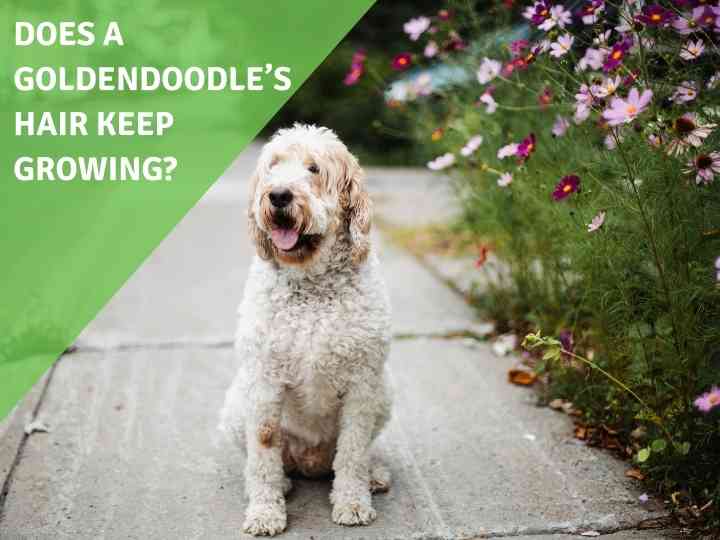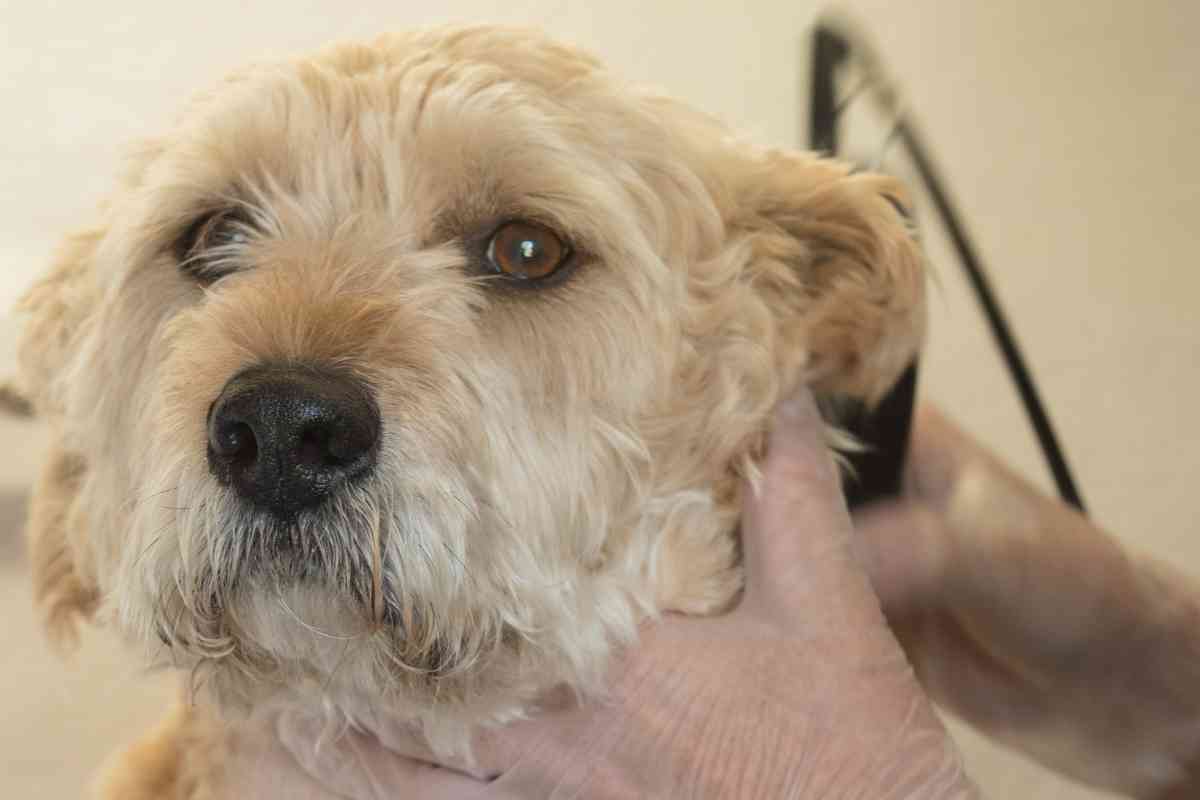Does A Goldendoodle’s Hair Keep Growing?
Many prospective pet parents are attracted to Goldendoodles because of their gorgeous hair.
The fact that they have hair instead of fur means that they are a much more hypoallergenic and allergy-free breed than most, but that hair comes at a high price in the form of a lot of maintenance.
You may be wondering if there is ever a point at which your Goldendoodle’s hair will ever stop growing!

Does A Goldendoodle’s Hair Keep Growing?
A Goldendoodles hair never stops growing, and it goes through phases that make up the hair growth cycle. While it doesn’t stop growing, at some point, it will go dormant and eventually fall out, but this happens much differently than with other dogs because of their Poodle ancestors.
All dogs’ hair keeps growing throughout their lives, Goldendoodle, Poodle, or any other breed.
However, dogs that tend to have shorter hair have a shorter growth cycle where their hair sheds afterward, and this is known as the anagen phase of their hair growth cycle.
Dogs categorized as having fur like the German Shepherd will typically have the shorter anagen phase because their fur sheds and replaces itself quicker.
As the seasons change, these dogs will shed their fur coat in spring and fall.
Dogs like the Goldendoodle and Poodle will be considered to have hair because the anagen phase of their hair growth cycle is longer, which means less shedding, less dander being thrown all around, and longer, more labor-intensive hair to groom.
Either way, no dog’s hair or fur ever stops growing; the phase of hair growth is just different.
The same can be said for us, we shed hair every day, but the process of hair growth never stops.
Goldendoodles have hair that grows to approximately 8 inches but may not look like that if it is matted, tangled, or knotted.
Depending on the type or style of hair the Goldendoodle is born with, their hair might look like it is long or not.
Flat or smooth coated Goldendoodles will have hair that doesn’t grow as long as they typically lean more towards the Golden Retriever purebred parent.
Their fur may be a little shorter, and it will have the appearance of the Golden Retriever parent.
Those Goldendoodles who have curly hair will have it grow to eight inches, but it may not look like that when it does as it is curly and twisted around.
Wavy-coated Goldendoodles, which is the image we usually associate with this breed, can have their hair grow to eight inches, and it will look like it because the hair is less curled and twisted.
In truth, the process of hair growth never stops or ends unless a dog has a health issue that is causing this symptom. Instead, the process is shorter for some dogs than others but continues every day of their lives.

How Does A Goldendoodle’s Hair Grow?
A Goldendoodle’s hair growth process is a lifelong cycle of hair growth, a resting phase where there is no hair growth and eventually falls out.
There are four phases in this cycle: the anagen phase, catagen phase, telogen phase, and exogen phase. Each of these parts of the hair growth cycle for a dog works differently as follows.
Anagen Phase
This phase of the hair growth cycle is when the hair is growing.
Catagen Phase
This phase of the hair growth cycle is when the hair is completely grown to its full potential.
Telogen Phase
This phase of hair growth is when the hair is dormant or sleeping but still attached to the dog’s skin.
Exogen Phase
This phase of hair growth is when the hair falls out via shedding.
Once the last phase has completed itself, the first phase begins again in a cycle, like the cycle of life.
Each phase is different in length, and some dog’s breeds will have one phase shorter or longer than another depending on their genetics.
Dogs who have hair like the Goldendoodle and the Poodle have a longer Anagen phase of their hair growth cycle, so they don’t shed as much as other dogs.
This doesn’t mean that their hair ever stops growing as the cycle of hair growth always continues; it just slows down, goes to sleep for a while, and so forth.
Each dog is unique due to genetics and lifestyle. Their hair grows and how fast or slow they are based on those genetics.
Due to their genetics, the Goldendoodle takes after the Poodle purebred parent and will follow along the same lines of having hair and a longer anagen hair growth phase. This will also mean that their exogen phase will be shorter too.
Now, this doesn’t mean that there isn’t a Goldendoodle out there somewhere that doesn’t have a different hair growth cycle falling in line with the Golden Retriever side of the genetics, but there are not many of them.
As with anything, when you crossbreed a pair of dogs, variances can happen unless you are a skilled breeder, but this still won’t change the fact that their hair never really stops growing.
What are some health conditions that stop hair growth for a Goldendoodle?
Health conditions that can cause your Goldendoodles’ hair to stop growing or cause it to fall out too include allergies. Some dogs can suffer from an assortment of allergies.
Goldendoodles can develop allergies to things in their immediate environments like plants and pollen, but they can also develop allergies to food.
Allergies can cause the Goldendoodle to suffer numerous symptoms, not just limited to their hair.
Symptoms can be subtle or severe depending on how intense the actual allergy is for the Goldendoodle.
The Goldendoodle might have itchiness but not lose any of their hair, some dogs will have bald spots that they are pulling at to relieve the allergy and irritation.
Mange can cause a dog to lose their hair. Mange is an inflammatory disease caused by a specific mite.
Ringworm can also cause issues with dogs’ hair and make them lose their hair or have it stop growing.
Ringworm is a fungal infection that affects their skin and hair.
Finally, Cushing’s Disease, which affects a dog’s adrenal glands, can cause issues with Goldendoodles hair and show other body symptoms.